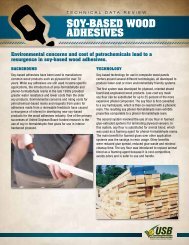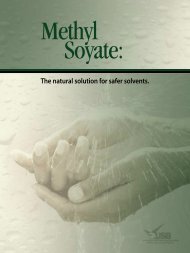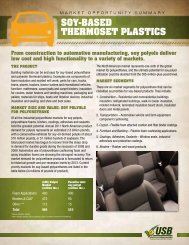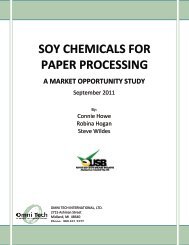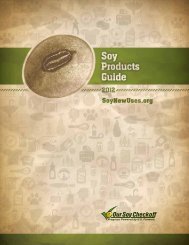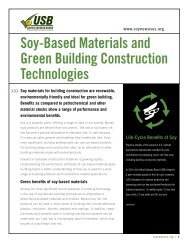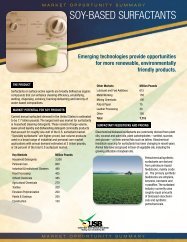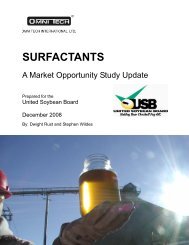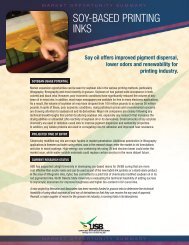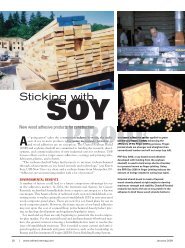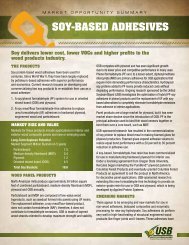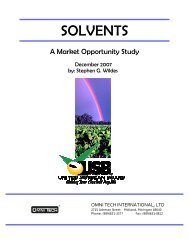SOY-BASED PAINTS AND COATINGS - Soy New Uses
SOY-BASED PAINTS AND COATINGS - Soy New Uses
SOY-BASED PAINTS AND COATINGS - Soy New Uses
Create successful ePaper yourself
Turn your PDF publications into a flip-book with our unique Google optimized e-Paper software.
MARKET OPP0RTUNITY SUMMARY<br />
<strong>SOY</strong>-<strong>BASED</strong> <strong>PAINTS</strong> <strong>AND</strong><br />
<strong>COATINGS</strong><br />
<strong>Soy</strong>bean-oil-based polymers help paint industry<br />
reduce VOCs and lower raw material costs.<br />
<strong>Soy</strong>bean Usage Potential<br />
Updated market studies directed at the coatings industry indicate<br />
that emulsion polymers will continue to grow in a major segment –<br />
architectural interior and exterior coatings. This is expected once<br />
the housing and construction market turns around. The United<br />
<strong>Soy</strong>bean Board continues to fund projects for developing emulsion<br />
compatible systems and feasibility studies for soy polyols in industrialcoatings<br />
that will reverse the 10-year trend of reduced consumption<br />
of soybean oil in resins, paints and varnishes. Current consumption<br />
in these areas is about 22 million bushels of soybeans.<br />
According to the latest Census Reports for the 2008 year, the paint<br />
industry decreased in volume shipped by 11 percent to 1,222.4 million<br />
gallons. Shipment value decreased 6 percent to $18,421.3 million.<br />
The architectural coatings segment was the hardest hit for the year<br />
with a volume decline of 11 percent to 682 million gallons. The<br />
value decrease was 12 percent to $8,669 million. The housing and<br />
construction industry slowdown is still adversely affecting the total<br />
coatings industry.<br />
Projected Time to Market Entry<br />
Market entry was started in 2003 with substantial penetration<br />
expected within the next 5-10 years. <strong>New</strong> Century Coatings has<br />
expanded its distribution of the soy-methyl-ester-based coatings<br />
to include a new architectural paint called Dura <strong>Soy</strong> One. Green<br />
Products Inc. has nationally expanded its soy-based roof, metal and<br />
concrete coatings product line and introduced a premium 15-year<br />
guaranteed soy-oil-based roof coating called ELMS Platinum. TKO<br />
Waterproof Coatings of Woodstock, Ill., has also introduced a line<br />
of roofing products. Rust-Oleum introduced their Varithane clear<br />
soy polyurethane wood coating in 2009, and Sherwin-Williams is<br />
near a full market introduction of a new soy/polyester/acrylic hybrid<br />
industrial coating.<br />
Current Research Status<br />
Fisher Composites and Battelle have developed a standard-cure soy<br />
containing powder coating to the point where a major resin company<br />
has exercised an option to license the new technology. This new<br />
soy-based resin was introduced to John Deere in 2008. Long-term<br />
weathering studies continue.<br />
Lehigh University has completed the feasibility study of replacing<br />
acrylic polymers in both ultraviolet-cured inks and wood coatings. A<br />
new commercial marketing team composed of Sun Chemical, Lehigh,<br />
Northampton Community College and Omni Tech have been formed to<br />
commercialize the resin in 2009. A major resin company has expressed<br />
an interest in running lab trials with the new soy-based lithographic ink.<br />
Sherwin-Williams is in<br />
phase 1 of developing a<br />
new soy/acrylic architectural<br />
coating to meet<br />
a VOC content of 50 g/l.<br />
This product could be<br />
commercialized in the<br />
2010-2011 time period.<br />
PPG is near commercialization<br />
of two new<br />
coatings containing<br />
soy. In one coating soy<br />
polyols will be used to<br />
replace petrochemical soy polyols in the flexible coating of a<br />
major footwear product. In another coating, glycerin is being<br />
evaluated as a clear coating over a plastic substrate. Both coatings<br />
should be commercialized in 2010.<br />
MARKET OPP0RTUNITY SUMMARY<br />
38508_MOS_Coatings 1<br />
6/7/10 1:57:16 PM
MARKET OPP0RTUNITY SUMMARY<br />
<strong>SOY</strong>-<strong>BASED</strong> <strong>PAINTS</strong> <strong>AND</strong> <strong>COATINGS</strong><br />
Rust-Oleum has been awarded a contract to make a new line of soy<br />
acrylic water-based stains and coatings. This resin will be based upon<br />
previous work supported by the USB at Eastern Michigan for a nonyellowing<br />
soy acrylic resin.<br />
Reichhold is being supported by the USB to develop an<br />
environmentally friendly water-based traffic paint. The coating will<br />
utilize new water-based soy alkyd latex technology to compete<br />
against acrylic traffic paints.<br />
Outlook for Future USB Support Required to<br />
Achieve Broad Market Acceptance<br />
Coatings TAP meetings have focused on supplementing university<br />
research efforts with the private sector through joint projects or<br />
consortia involving raw material producers, resin producers and<br />
coatings manufacturers.<br />
Project Coverage versus Market Opportunity<br />
Economics and environmental considerations are two key factors<br />
driving change in today’s coatings marketplace. Paint and coatings<br />
manufacturers are focusing on developing cost-effective technology<br />
and providing products that enhance performance and meet<br />
government regulations. The researchers have generated broader<br />
interest in soy-derived coatings through technical presentations at<br />
local and national coatings seminars and trade association meetings<br />
and with publication of technical papers in technical journals.<br />
Battelle’s new soy-based powder coating resin system will allow soy<br />
materials to penetrate the fastest-growing coatings market. In addition,<br />
the new soy powder coating resin will give the coatings formulator new<br />
tools to use on previously difficult-to-cure substrates.<br />
Lehigh University’s work will allow the replacement of more expensive<br />
acrylate polymers with soy materials as well as improve the cure rates<br />
and performance properties of 100 percent acrylate systems.<br />
The Sherwin-Williams project will provide one of the lowest VOC<br />
products in the marketplace. In addition, the anticipated soy content<br />
will allow the finished coating to meet guidelines for preferred federal<br />
procurement.<br />
The PPG project will move forward on the corporate mission to provide<br />
more environmentally friendly coatings. It is also the USB Program’s<br />
first feasibility study in coatings to determine if soy polyols can replace<br />
petrochemical polyols.<br />
The Reichhold soy-based traffic paint can reclaim what once was<br />
a major market for soy-based-solvent traffic paints. Acrylics have<br />
captured 90 percent of this million-pound paint market due to the<br />
more environmentally friendly nature of water-based acrylics.<br />
Issues Affecting Commercial Success<br />
Industry scientists and engineers are rapidly moving toward solving<br />
major issues for soy-derived water-based coatings – hydrolytic stability<br />
(shelf life) and yellowing – as well as customer satisfaction in ease of<br />
application, speed of drying of finished product, cleanup, etc. All of these<br />
critical issues are addressed on a daily basis through communication<br />
among technical and marketing people. Coating Technical Advisory Panel<br />
(TAP) meetings enable scientists and marketers to prioritize and plan for<br />
solving industry problems, contributing to reversing the downward trend<br />
of soy-based polymer use in architectural paints.<br />
TAP members were advised that, due to cutbacks in industry labs,<br />
evaluations of experimental products are moving in a new direction.<br />
Coating companies are advising suppliers to furnish samples in the<br />
“formulated state” – meaning the preparation of a ready-to-use<br />
paint, rather than a basic resin. This places additional responsibilities on<br />
the principal investigators who direct the research. Because of this<br />
trend, more emphasis will be placed on principal investigators with<br />
extensive labs who partner with a willing coatings<br />
manufacturer that will clearly define its needs.<br />
More and more emphasis is being placed upon zero/low VOC paints<br />
as odor and toxicity become problems in institutional and retail<br />
markets. The Sherwin-Williams project is expected to deliver one of<br />
the most user friendly coatings in the marketplace. There is a great<br />
interest in sustainable technology in coatings, and soy is expected<br />
to play a large role in resolving this issue.<br />
ABOUT USB<br />
USB is made up of 68 U.S. farmer-directors who oversee the<br />
investments of the soybean checkoff, a U.S. soybean research<br />
and promotion program, on behalf of all U.S. soybean farmers.<br />
Checkoff funds are invested in the areas of animal utilization,<br />
human utilization, industrial utilization, industry relations, market<br />
access and supply. As stipulated in the <strong>Soy</strong>bean Promotion,<br />
Research and Consumer Information Act, USDA’s Agricultural<br />
Marketing Service has oversight responsibilities for USB and the<br />
soybean checkoff.<br />
The two new projects from Rust-Oleum and Northampton<br />
Community College will expand our work into new soy-based<br />
wood stains and coatings.<br />
For more information, visit: soynewuses.org<br />
©2010 United <strong>Soy</strong>bean Board [38508-MOSC-3/10]<br />
MARKET OPP0RTUNITY SUMMARY<br />
38508_MOS_Coatings 2<br />
6/7/10 1:57:31 PM



